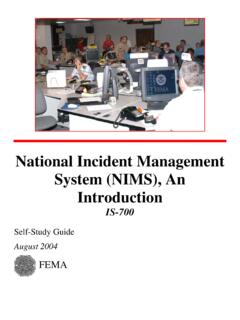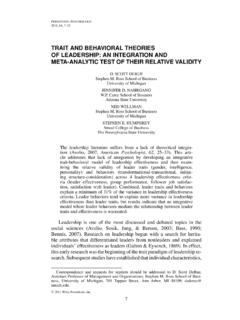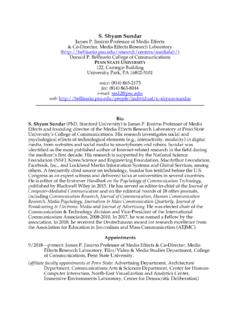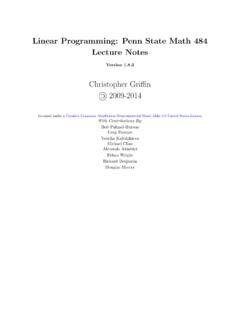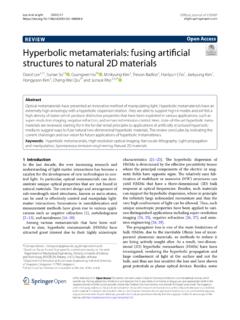Transcription of 11.1 ORTHOGONAL FUNCTIONS - Pennsylvania State …
1 ORTHOGONAL FUNCTIONSREVIEW MATERIAL The notions of generalized vectors and vector spaces can be found in any linear algebra concepts of geometric vectors in two and three dimensions, orthogonalor perpendicular vectors, and the inner product of two vectors have been generalized. It is perfectlyroutine in mathematics to think of a function as a vector. In this section we will examine an innerproduct that is different from the one you studied in calculus. Using this new inner product, wedefine ORTHOGONAL FUNCTIONS and sets of ORTHOGONAL FUNCTIONS .
2 Another topic in a standard calculuscourse is the expansion of a function fin a power series. In this section we will also see how toexpand a suitable function fin terms of an infinite set of ORTHOGONAL CHAPTER 11 ORTHOGONAL FUNCTIONS AND FOURIER PRODUCTR ecall that if uandvare two vectors in 3-space, then theinner product (u,v) (in calculus this is written as u v) possesses the followingproperties:(i)(u,v) (v,u),(ii)(ku,v) k(u,v),ka scalar,(iii)(u,u) 0 if u 0and (u,u) 0 if u 0,(iv)(u v,w) (u,w) (v,w).
3 We expect that any generalization of the inner product concept should have thesesame that f1andf2are FUNCTIONS defined on an interval [a,b].*Since adefiniteintegralon [a,b] of the product f1(x)f2(x) possesses the foregoing properties (i) (iv)whenever the integral exists, we are prompted to make the following Product of FunctionsTheinner productof two FUNCTIONS f1andf2on an interval [a,b] is thenumberORTHOGONAL FUNCTIONSM otivated by the fact that two geometric vectorsuandvare ORTHOGONAL whenever their inner product is zero, we define orthogonalfunctionsin a similar FunctionsTwo FUNCTIONS f1andf2areorthogonalon an interval [a,b] if(1)(f1,f2) baf1(x)f2(x)dx 0.
4 (f1,f2) baf1(x)f2(x)dx.*The interval could also be ( , ), [0, ), and so example, the FUNCTIONS f1(x) x2andf2(x) x3are ORTHOGONAL on the interval[ 1, 1], sinceUnlike in vector analysis, in which the word orthogonalis a synonym for perpendic -ular,in this present context the term orthogonaland condition (1) have no SETSWe are primarily interested in infinite sets of SetA set of real-valued FUNCTIONS {f0(x),f1(x),f2(x),..} is said to beorthogonalon an interval [a,b] if(2)ORTHONORMAL SETSThe norm, or length u , of a vector ucan be expressedin terms of the inner product.]
5 The expression (u,u) u 2is called the square norm,and so the norm is u Similarly, the square normof a function fnis fn(x) 2 (fn,fn), and so the norm,or its generalized length, is fn(x) In other words, the square norm and norm of a function fninan ORTHOGONAL set {fn(x)} are, respectively, fn(x) 2 and fn(x) (3)If {fn(x)} is an ORTHOGONAL set of FUNCTIONS on the interval [a,b] with the propertythat fn(x) 1 for n 0, 1, 2, .. , then {fn(x)} is said to be an orthonormal seton the 1 ORTHOGONAL Set of FunctionsShow that the set {1, cos x, cos 2x.}
6 } is ORTHOGONAL on the interval [ p,p].SOLUTIONIf we make the identification f0(x) 1 and fn(x) cosnx, we mustthen show that We have, in the first case, 1n sin nx 1n [sin n sin ( n )] 0, n 0, ( 0, n) 0(x) n(x)dx cosnx dx 0(x) n(x)dx 0, n 0, and m(x) n(x)dx 0, m baf2n(x)dx. ba n2(x)dx1( n, n).1(u, u).( m, n) ba m(x) n(x)dx 0, mYn.(f1,f2) 1 1x2 x3dx 16x6 1 1 FUNCTIONS 399and, in the second,; trig identityEXAMPLE 2 NormsFind the norm of each function in the ORTHOGONAL set given in Example f0(x) 1 we have, from (3), f0(x) 2 so f0(x) For fn(x) cosnx,n 0, it follows that fn(x) 2 Thus for n 0, fn(x) Any ORTHOGONAL set of nonzero FUNCTIONS {fn(x)},n 0, 1, 2.
7 Can benormalized that is, made into an orthonormal set by dividing each function byits norm. It follows from Examples 1 and 2 that the setis orthonormal on the interval [ p,p].We shall make one more analogy between vectors and FUNCTIONS . Supposev1,v2, and v3are three mutually ORTHOGONAL nonzero vectors in 3-space. Such anorthogonal set can be used as a basis for 3-space; that is, any three-dimensional vec-tor can be written as a linear combination(4)where the ci,i 1, 2, 3, are scalars called the components of the vector.
8 Eachcomponentcican be expressed in terms of uand the corresponding vector vi. To seethis, we take the inner product of (4) with v1:(u,v1) c1(v1,v1) c2(v2,v1) c3(v3,v1) c1 v1 2 c2 0 c3 like manner we find that the components c2andc3are given byc2 (u,v2)'v2'2 and c3 (u, v3)'v3' (u,v1)'v1'2 .u c1v1 c2v2 c3v3, 112 ,cosx1 ,cos 2x1 , .. 1 . cos2nx dx 12 [1 cos 2nx]dx .12 . dx 2 , 12 sin (m n)xm n sin (m n)xm n 0, m n. 12 [cos (m n)x cos (m n)x]dx cosmx cos nx dx ( m, n) m(x) n(x)dx400 CHAPTER 11 ORTHOGONAL FUNCTIONS AND FOURIER SERIESH ence (4) can be expressed as(5) ORTHOGONAL SERIES EXPANSIONS uppose {fn(x)} is an infinite orthogo-nal set of FUNCTIONS on an interval [a,b].
9 We ask: If y f(x) is a function defined onthe interval [a,b], is it possible to determine a set of coefficients cn,n 0, 1, 2, .. ,for which?(6)As in the foregoing discussion on finding components of a vector we can find thecoefficients cnby utilizing the inner product. Multiplying (6) by fm(x) and integratingover the interval [a,b] givesf(x) c0 0(x) c1 1(x) cn n(x) u (u, v1)'v1'2v1 (u, v2)'v2'2v2 (u, v3)'v3'2v3 3n 1(u, vn)'vn' FUNCTIONS 401 c0( 0, m) c1( 1, m) cn( n, m) . baf(x) m(x)dx c0 ba 0(x) m(x)dx c1 ba 1(x) m(x)dx cn ba n(x) m(x)dx By orthogonality each term on the right-hand side of the last equation is zero exceptwhenm n.
10 In this case we haveIt follows that the required coefficients areIn other words,(7)where(8)With inner product notation, (7) becomes(9)Thus (9) is seen to be the function analogue of the vector result given in (5).DEFINITION Set / Weight FunctionA set of real-valued FUNCTIONS {f0(x),f1(x),f2(x), ..} is said to beorthogonal with respect to a weight functionw(x) on an interval [a,b] ifThe usual assumption is that w(x) 0 on the interval of orthogonality [a,b].The set {1, cos x, cos 2x, ..} in Example 1 is ORTHOGONAL with respect to the weightfunctionw(x) 1 on the interval [ p,p].
